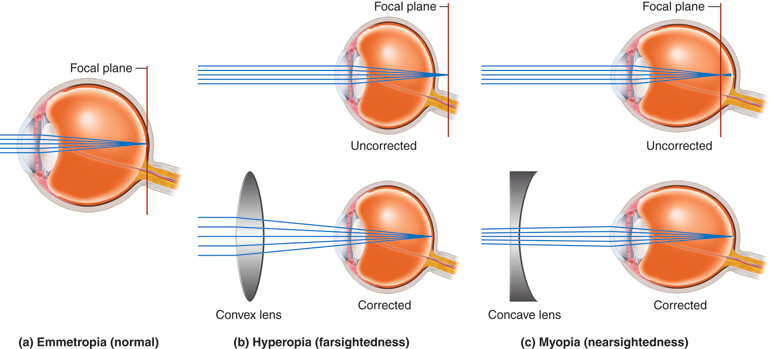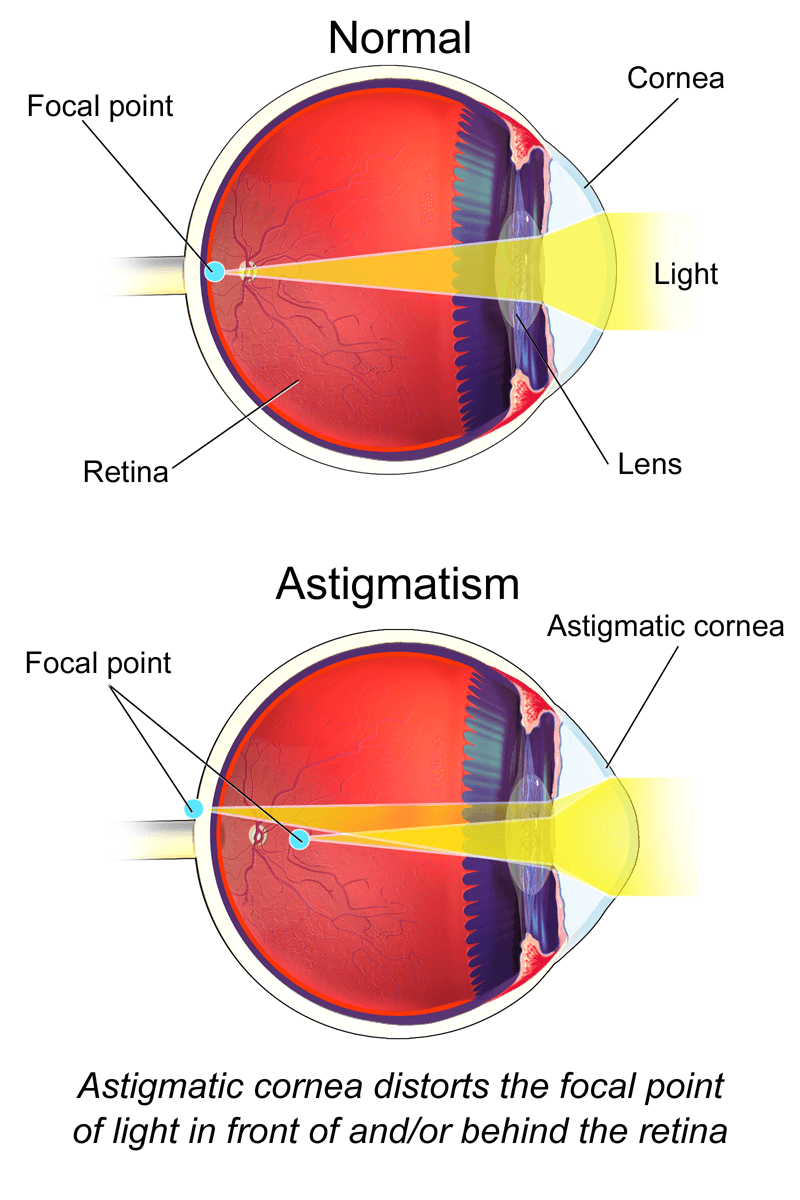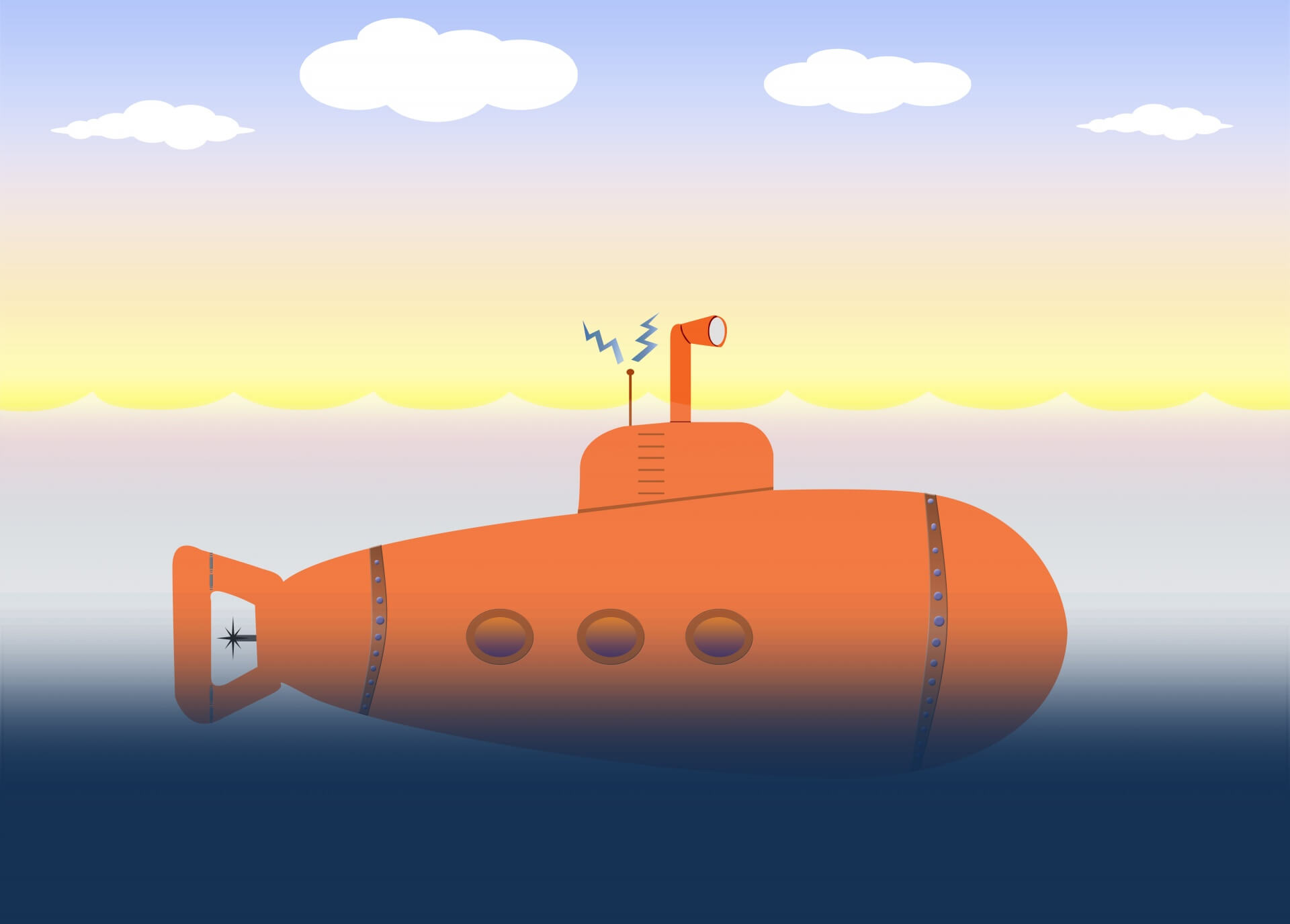Optical Instruments
In this article, we are going to study about the various natural and man-made optical devices and instruments, e.g. eye, telescopes, microscopes, periscope, kaleidoscope, binoculars, etc. These instruments make use of the optics principles related to mirrors, lenses and prisms, such as reflection, refraction, etc.
 Table of Contents
Table of Contents- Human Eye
- Microscope
- Telescope
- Periscope
Human Eye
Though almost all animals have eyes, they may differ to a certain extent from one species to another. Herein, we will restrict ourselves to human eye, as the basic concept is almost the same in all kinds of eyes (at least from Physics perspective).

The process via which our eye constructs an image of the outside objects is as follows:
- Cornea: Light enters the eye through cornea, which is a curved front surface.
- Pupil: Thereafter, the light passes through a small hole in the middle of the iris, called pupil. We can increase or decrease the size of the pupil using muscles. Under bright light the size of the pupil decreases so as to reduce the amount of light entering our eye, and vice-versa.
- Eye Lens: Now the light passes through a convex lens, which is made of a jelly like material. Using ciliary muscles, we can change the shape/curvature of the lens, and hence modify its focal length. This property of the eye is called ‘accommodation’.
- Retina: The eye lens focuses the light onto a film of nerve fibres covering the curved back surface of the eye. This back surface of the eye is called retina. Retina is covered with light sensitive cells – rods and cones. They sense light intensity and colour. The image formed by a human eye is real and inverted.
- Optic Nerve: Light of this image is converted into electrical signals by retina, and these signals are transmitted to the brain via optic nerves.
- These electrical signals from both the eyes are finally merged and interpreted by the brain, and we perceive the image as upright. This is the power of our brain – it uses two different upside-down images as an input and help us see a single upright image.
Near Point and Far Point
- Near Point: It is the closest possible distance between the eye lens and outside object, for which the lens can focus light on the retina. Near point is also known as least distance of distinct vision, and is often denoted by the symbol D. For an eye with normal vision, it’s considered to be 25 cm.
- Far Point: It is the farthest possible distance between the eye lens and outside object, for which the lens can focus light on the retina. Far point of normal eye is at infinity. Our eye cannot see an object clearly if it’s too close. That’s because to focus the image of such an object on to the retina, the eye lens has to curve a lot, which is not possible. That’s why the image formed is blurred.
Defects of Human Eye
Myopia or Near-sightedness
A person suffering from myopia showcase the following symptoms:
- He can clearly see near objects.
- He cannot clearly see far/distant objects.

This happens when light rays emerging out of the eye lens converge short of the retina, i.e. the image is formed in front of the retina, rather than on it.
To rectify this eye defect, concave lens is used.
Hypermetropia or Far-sightedness
A person suffering from hypermetropia showcase the following symptoms:
- He cannot clearly see near objects.
- He can clearly see far/distant objects.
This happens when light rays emerging out of the eye lens converge behind the retina, i.e. the image is formed behind the retina, rather than on it.
To rectify this eye defect, convex lens is used.
Presbyopia
If ciliary muscles lose their capability to change the shape/curvature of the eye lens to a certain extent, the person’s power of accommodation of the eye will degrade. If this happens, the person would find it hard to clearly see either near or distant objects.
This generally happens in old age. To rectify this eye defect, bifocal lens is used.
Astigmatism
A person having this eye defect cannot simultaneously see horizontal and vertical lines distinctly at a normal distance.

The reason for this defect is non-spherical shape of cornea. The curvature of cornea could be larger in the vertical plane as compared to the horizontal plane or vice-versa.
To rectify this eye defect, cylindrical lens is used.
 Note
NoteAstigmatism can occur along with myopia or hypermetropia.
Colour blindness
A person suffering from this defect is unable to distinguish among few colours, e.g. between red and green. The reason behind this defect is the improper functioning of any one of the three types of cones.
We cannot rectify this eye condition as it’s a genetic disorder – it passes from one generation to another.
Cataract
A person suffering from this eye defect loses vision in his eye partially or completely. This happens because an opaque, white membrane develops on cornea.

This defect can be rectified through surgery, wherein the opaque, white membrane is removed.
Microscope
Microscope is an optical device used to see the minute details of very small objects placed nearby.

Microscopes can broadly be categorized into two categories:
- Simple microscope or Magnifier: They are just made up of a convex lens of short focal length. The magnifying power of a simple microscope, M = [1 + D/f], where D is the least distance of distinct vision.
- Compound microscope: They make use of two lenses, wherein one lens compounds the effect of the other, producing larger magnifications.
This is how a compound microscope works:
- Light from the object falls on the lens near it, called the “objective”. It in turn creates a real, inverted, magnified image of the object, which acts as an object for the second lens. Let the magnification caused by this lens be mo.
- Now, the light passes through the second lens, called the “eyepiece”. This lens essentially just works as a simple microscope. The image formed by this lens is enlarged, virtual and inverted with respect to the original object. Let the magnification caused by this lens be me.
For compound microscope, the combined magnification, m = mo × me
 Note
NoteIn case of microscope, Focal length of objective < Focal length of eyepiece.
 Note
NoteThe technology of compound microscopes has further improved with time. Nowadays, in modern microscopes, multicomponent lenses are used for both the objective and the eyepiece (not just two simple lens). This leads to better magnification and image clarity/quality, as various optical aberrations and defects in lens are minimized.
Telescope
Telescope is an optical device used to see the minute details of very large, distant objects (i.e. objects placed far away from the observer). The first astronomical telescope was invented by Kepler in 1611.

Telescopes can broadly be categorized into two categories:
- Simple telescope: They make use of two convex lens.
- Reflecting telescope: They make use of both lens and mirror.
Let’s understand them one by one.
Simple telescope
This is how a simple telescope works:
- Light from the distant object falls on the lens near it, called the “objective”. It’s a convex lens. It in turn creates a real, image of the object at its second focal point, which acts as an object for the second lens. Let the focal length of this lens be fo.
- Now, the light passes through the second lens, called the “eyepiece”. It’s also a convex lens. The image formed by this lens is enlarged, and inverted. Let the focal length of this lens be fe.
Magnifying power of telescope, m = fo / fe
And, Length of telescope tube in astronomical telescope, L = fo + fe
 Note
NoteIn case of telescope, the objective has a larger focal length. That is, Focal length of objective > Focal length of eyepiece.
Also, aperture of objective is much larger than that of the eyepiece. That is, Aperture of objective > Aperture of eyepiece.
Aperture of a lens is the diameter of that lens. It controls the amount of light that can pass through the lens.
Reflecting telescope
A more effective astronomical telescope needs to:
- gather a lot of light, i.e. it should have high light gathering power.
- have high resolution, i.e. it should have high resolving power. It means that, it should be able to tell apart two objects distinctly, which are in very nearly the same direction.
More the area/diameter of the objective, the more light will it be able to gather, and more will be its resolution. So, both light gathering power and resolving power of a telescope depends on the size of the objective.
So, engineers aim to make optical telescopes with as big objective as possible. However, constructing and using big lens as objective poses many challenges, such as:
- The bigger the lens, the heavier they tend to become. It makes it extremely difficult to construct them, and to support them by their edges.
- Such big lenses tend to have chromatic aberration, and create images with distortions.
- Such big lenses are very expensive to make, especially if they have to be kept free of chromatic aberration and other optic defects.
Because of these reasons, in modern telescopes, engineers started using concave mirror rather than a lens for the objective. Such a telescope having mirror objective is called reflecting telescope.
It has following advantages over normal telescopes:
- As weight of a mirror is much less than that of a lens of equivalent optical quality, it’s easier to manage and support them. A mirror can be supported over its entire back surface, not just over its rim.
- Mirrors do not suffer from chromatic aberration.
- The issue of spherical aberration can also be resolved if parabolic reflecting surface is used.
Periscope
You must have seen a periscope in movies related to submarines – it’s a pipe like structure that you see coming out of the top of a submarine, and used by submariners to keep a watch around the vessel while still keeping the submarine submerged under the water.

Periscope is based upon the principles of reflection and refraction. It is constructed using two plane mirrors, separated by some distance and inclined at an angle of 45o.
The process via which we see an image using a Periscope is as follows:

- The light rays incident on the first (upward) plane mirror are reflected towards the other mirror.
- The light rays incident on the second (downward) plane mirror are reflected towards the eye of the observer.
